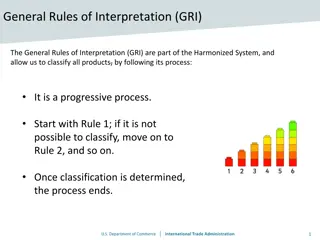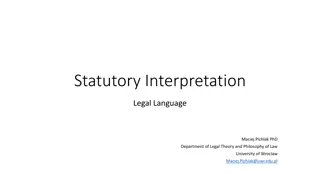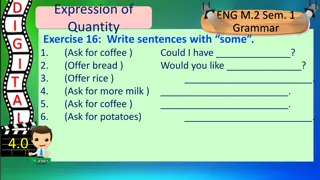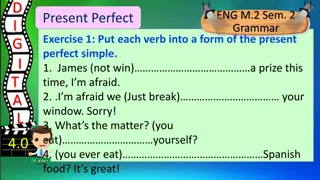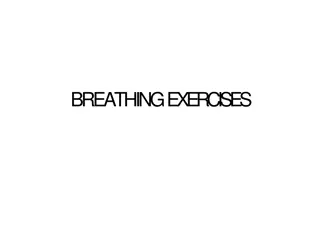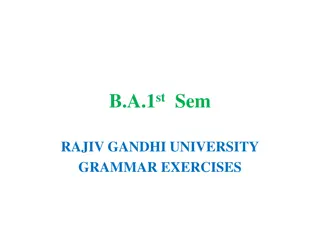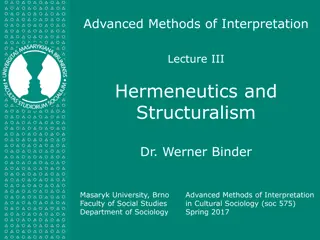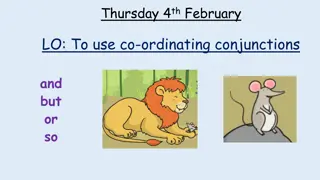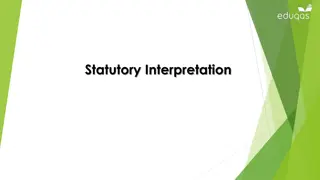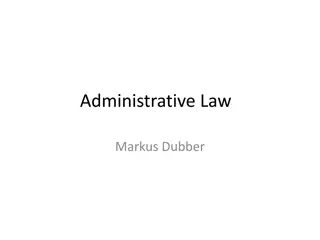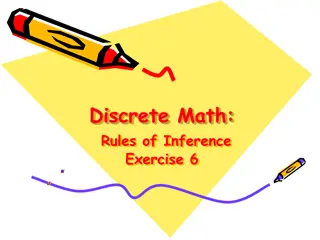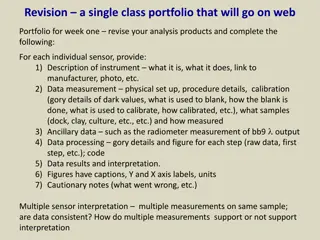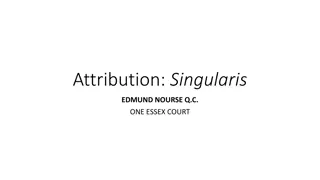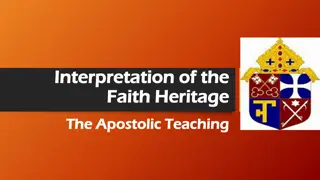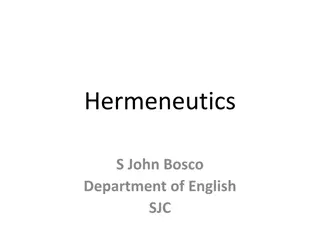Understanding Interpretation Rules: Practical Examples and Exercises
Explore the importance of interpreting biblical passages in context, illustrated through examples like 1 John 3:6-10. Understand how historical and cultural background inform interpretation, emphasizing the need to consider surrounding text, book purpose, and broader biblical themes. Engage in exercises like analyzing John 3:30 and 1 Thessalonians 4:16-17 for deeper insight.
Download Presentation

Please find below an Image/Link to download the presentation.
The content on the website is provided AS IS for your information and personal use only. It may not be sold, licensed, or shared on other websites without obtaining consent from the author. Download presentation by click this link. If you encounter any issues during the download, it is possible that the publisher has removed the file from their server.
E N D
Presentation Transcript
Grace Bible Church Glorifying God by Making Disciples of Jesus Christ Download notes at: GraceBibleNY.org/hermeneutics
Grammatical Principles of Interpretation Rule 13 Interpret a passage in harmony with its context Four questions 1) How does the passage relate to the material surrounding it? (paragraph, chapter, section) 2) How does it relate to the rest of the book? 3) How does it relate to the Bible as a whole? 4) How does it relate to the culture & background when it was written?
Rule 13 Interpret a passage in harmony with its context Example: 1 John 3:6-10 If isolated from its context, it appears the Christian never sins. In answering the four previous questions, what does the passage actually mean? NEAR CONTEXT: Purification (3:3), not practicing sin (3:4) and Jesus taking it away BOOK PURPOSE: Bring people into fellowship (1:3) & know they have eternal life (5:13). The difference between a believer and non-believer is having the Son (5:12) And confession of sin (1:9)
Rule 13 Interpret a passage in harmony with its context Example: 1 John 3:6-10 BIBLE AS A WHOLE: An epistle presenting the Tests of Fellowship - explaining characteristics of those who are Jesus disciples and those who are not. CULTURE & BACKGROUND: Late 1st Century. The apostle John is battling early gnostic heresy that is beginning to show up in Ephesus
Rule 13 Interpret a passage in harmony with its context Each of the Gospel accounts emphasize a different aspect of Jesus Matthew - Jesus the King / Messiah Mark - Jesus the Servant (10:45) Luke - Jesus the Son of Man - Seeking & Saving the Lost - (5:32) John - Jesus the Son of God (20:31)
Rule 13 Exercises, page 245 1. Read John 3:30 along with its context and answer the following: a. Who are the he and I in this verse He = Jesus, the Christ I = John b. What was the issue that prompted this comment? Vs. 25 - a discussion of purification c. In the illustration of the bridal party, who is John? John is the friend of the bridegroom (vs. 29)
Rule 13 Exercises, page 245 2. Read 1 Thessalonians 4:16-17 and note its context a. Why does Paul mention the resurrection of God s people? To give them the comfort of hope - vs. 18 b. What concern did the Thessalonians have that prompted Paul to give this assurance? Vs. 13-14 - the were concerned about those who had fallen asleep i.e. had already died
Rule 13 Exercises, page 245 3. Interpret Luke 16:9 in light of its context And I say to you, make friends for yourselves by means of the wealth of unrighteousness, so that when it fails, they will receive you into the eternal dwellings Use your riches to bring people into God s kingdom where you will dwell eternally with one another
Context Study Handout The relationship of the unit of thought to the whole
Context Study Handout The relationship of the unit of thought to the whole 1) The context of the whole of Scripture gives the general perspective and governs the fundamental assumptions (i.e. sets the limits of meaning) for the interpreter. Scripture interprets Scripture. The "hermeneutical circle" shows that we cannot understand the whole unless we understand the parts and we can not understand the parts without understanding the whole. Interpretation involves a rotation from part to whole and whole to part.
Context Study Handout The relationship of the unit of thought to the whole 2) The context of the Testament - Old or New. Where does the passage fit in the progress of revelation. 3) The context of other books written by the same author 4) The context of the particular book. Who was the writer, who was it written to, why was the book written (i.e. the purpose of the book).
Context Study Handout The relationship of the unit of thought to the whole 5) The context of the immediate passage. Where does the particular passage fit in the flow of thought occurring before and after. Please note chapter and verse indicators are not part of the original. They have been added in modern times as a reference tool. They often must be ignored in trying to understand the flow of thought.
Context Study Handout The relationship of the unit of thought to the whole
Context Handout Exercises 1) Some modern day preachers use 1 Samuel 26:9 as a proof text that they should not be criticized. What is the context of this passage? Who is the "Lord's anointed" ? Context: David s refusal to kill Saul & instead wait for the Lord to remove him. Identity: Saul - the anointed King of Israel
Context Handout Exercises 2) 1 Corinthians 13:4-8 defines "love." What is the context of the book? The context of this section of the book (Ch. 12-14)? and the context of this chapter? What does this add to your understanding of what Paul is saying here? Book: Correction of errors / factions in Corinthian church. Section: Correction of spiritual things Chapter - using gifts for benefit of others vs. selfishness
Context Handout Exercises 3) Galatians 3:27-28 has been used by feminists to object to different roles for men and women. What is the context of this passage? Other writings of Paul; the flow of thought of this book; the immediate context of this verse? Passage: All are justified by faith, not the law Writings of Paul: Justification: Rom. 3-5, Gal. 2, etc. Gender roles: Eph. 5; Col. 3 Flow of book: Warning & opposition to false gospel, the righteousness of faith vs. the law. Immediate context: All believers have equal standing before God (Roles are not in view).
Context Handout Exercises 4) Revelation 3:20 has often been used as an evangelism verse. What is its context? Section: Overcoming spiritual apathy of Laodician church Immediate: Repentance of professing Christians
Context Handout Exercises 5) John 14:13 is used by many to claim anything they want from Jesus. What is the context? Section: Jesus unity with God the Father. Jesus is speaking to apostles. Transitions to ministry of Holy Spirit to come. Immediate Context: Love Jesus by keeping His commandments. Asking in name = according to that person s will. It is not an incantational formula.
Rule 14 When an inanimate object is used to describe a living being, the statement may be considered to be figurative Examples: The I Am passages of the Gospel of John Bread 6:35 Light 8:12 Door 10:7-9
Rule 14 When an inanimate object is used to describe a living being, the statement may be considered to be figurative Examples: Psalm 92:12 like a palm tree . . . Like a cedar Psalm 51:7 - purify my with hyssop Matthew 26:26-28 - Communion Take, eat; this is My body . . . this is My blood of the covenant . . .
Rule 14 When an inanimate object is used to describe a living being, the statement may be considered to be figurative Corollary : When life and action are attributed to inanimate objects, the statement may be considered figurative Micah 6:2 - hear, O mountains . . .
Exercises Rule 14 pages 245-246 1. The great I am passages in John regarding Jesus are an example of this rule. Find three more examples of this rule in the New Testament and three in the Old Testament New Testament Examples 2 Peter 2:13 stains & blemishes Jude 12-13 hidden reefs . . . Clouds without water . . . Wild waves of the sea . . . Matthew 23:27 & Acts 23:3 whitewashed tombs / wall
Exercises Rule 14 pages 245-246 1. The great I am passages in John regarding Jesus are an example of this rule. Find three more examples of this rule in the New Testament and three in the Old Testament Old Testament Examples Psalm 19:14 O Lord, my rock & redeemer Song of Solomon 2:1 I am the rose of Sharon, The lily of the valleys Proverbs 10:11 The mouth of the righteous is a fountain of life . . .
Exercises Rule 14 pages 245-246 Corollary - When life and action are attributed to inanimate objects, the statement may be considered figurative: Psalm 24:9 & Isaiah 55:12 are illustrations of this corollary. Using a concordance, find two other illustrations in each the Old Testament and New Testament Psalm 24:9 - lift up your heads, O Gates Isaiah 55:12 Mtns, fields shout for joy, trees clap their hands
Exercises Rule 14 pages 245-246 Old Testament Examples Psalm 98:8 - rivers clap their hands, Mtns sing Isaiah 44:23 lower earth, mtns, forest, trees shout for joy Job 31:38 land cries out, furrows weep
Exercises Rule 14 pages 245-246 New Testament Examples 1 Peter 2:4 living stone / stones James 5:3 rust will be a witness Luke 19:40 stones cry out Rev. 12:16 earth opened its mouth & drank
Types of Figures of Speech Simile: Two dissimilar things are compared by the use of "like" or "as." Psalm 1:3 - And he will be like a tree [firmly] planted by streams of water Metaphor: Expresses something by direct comparison, similarity or parallelism. Genesis 49:9 "Judah is a lion's whelp. . .
Types of Figures of Speech Hyperbole: Idea / event stated in exaggerated manner to stress its importance / quantity John 21:25 - And there are also many other things which Jesus did, which if they ^were written in detail, I suppose that even the world itself ^would not contain the books which ^were written Ellipsis: "Omission of a word clearly implied." Often occurs in Hebraism. Philippians 4:16 for even in Thessalonica you sent [a gift] more than once for my needs
Types of Figures of Speech Paradox: True statements that appear contradictory. (Could be solved with more understanding). 2 Cor. 12:10 . . . for when I am weak, then I am strong. An Antimony is a type of paradox in which an unavoidable contradictions to pure reasoning occur because of man's limitations in understanding - i.e. God's sovereignty vs man's free will Romans 3:10 There is none who seeks for God cf. Isaiah 55:6 Seek the Lord. . . Acts 17:30 - God is now declaring to men that all people everywhere should repent,
Types of Figures of Speech Irony: The use of words to express the opposite of what one really means 1 Cor. 4:8-10 You are already filled. . . become rich. . . become kings. . . prudent. . . strong. . . Synecdoche: The whole refers to a part - or a part to the whole Joshua 7:1,11 the sons of Israel acted unfaithfully in regard to the things under the ban, for Achan . . . Israel has sinned . . . they have even taken
Types of Figures of Speech Zeugma: A verb or adjective agreeing with a near word is by supplement also referred to another more remote word. Eph. 5:21-22 and be subject to one another in the fear of Christ. 22 Wives, [be subject] to your own husbands, as to the Lord. Euphemism: The substitution of a pleasant expression for an offensive or unpleasant one. John 11:11 "Our friend Lazarus has fallen asleep. .
Types of Figures of Speech Brachylogy: Expressing something in most concise manner - brevity (cf to Mt. 10:1-42) Compare Luke 9:1-5 with Matthew 10:1-42 Litotes: affirmative expressed by the negative of the contrary. Psalm 28:1 - To Thee, O Lord, I call; My rock, do not be deaf to me. . . Meiosis: Rhetorical understatement in order to give emphasis. 2 Kings 10:18 "Ahab served Baal a little; Jehu will serve him much
Types of Figures of Speech Oxymoron: Presence of antithesis makes apparent contradiction between a noun and its modifier. Matt. 6:23 If therefore the light that is in you is darkness, how great is the darkness! Personification: The inanimate takes on human or animal characteristics. Anthropomorphism - human characteristics Prov. 1:20f Wisdom shouts in the street, She lifts her voice in the square Biomorphism - animal or plant characteristics Ps 36:7 - How precious is Thy lovingkindness, O God! And the children of men take refuge in the shadow of Thy wings
Types of Figures of Speech Paronomasia: Pun - play on words for effect. Matthew 16:18 "And I also say to you that you are Peter (petros), and upon this rock (petra) I will build My church Metonymy: Exchange of one noun for another by their close association Proverbs 4:14 Do not enter the path of the wicked, And do not proceed in the way of evil men. Homeocentrisms /geocentrisms: The view from man s / earth s perspective Psalm 19:4-6 Its rising is from one end of the heavens, And its circuit to the other end of them
Figures of Speech - Exercises Hosea 13:3 - simile "be like " dissimilar compared by "like (Note: Simile: is as, as, or like - a comparison of what is dissimilar) Proverbs 12:4 - Metaphor she "is" - a direct comparison Note: The verb is is assumed, an ellipsis
Figures of Speech - Exercises Acts 23:3 - metaphor - you white washed wall - a direct comparison. Psalm 31:10 - Hyperbole - exaggeration to stress quantity of sorrow. 1 Corinthians 11:30 Euphemism uses sleep for dead
Figures of Speech - Exercises Ruth 2:12 - Biomorphism - God s wings animal characteristics 1 Cor. 12:17 Metaphoric hyperbolic synechoche - exaggeration to stress quantity of sorrow. 1 Corinthians 12:15 Anthropomorphism foot taking on other human characteristics
Figures of Speech - Exercises Jesus uses figures of speech to describe Himself in the following passages. What does each mean? John 6:48-51 I am the bread of life Metaphor He is the sustenance of life John 8:12 I am the Light of the world Metaphor He is the revealer of truth John 10:14-18 - I am the good shepherd Metaphor He is the protector of those who belong to Him John 15:1-5 I am the true vine Metaphor He is the source of life
Rule 15 - When an expression is out of character with the thing described, the statement may be considered figurative Philippians 3:2-3 The dogs refer to evil men who are exhibiting dog like characteristics - unclean - not to canines Luke 13:32 - tell that fox - refers to King Herod who was cunning - not to the animal John 1:36 - lamb of God is explained by OT prophecies about the messiah - Isaiah 53:7
Rule 15 - When an expression is out of character with the thing described, the statement may be considered figurative Lion - as in previous study - can mean many different things depending on the context Anthropomorphisms of God 2 Chron. 16:9, - The eyes of the Lord Exodus 33:23 hand, back, face . . .
Rule 15 - When an expression is out of character with the thing described, the statement may be considered figurative 1) A word cannot mean more than one thing at a time - i.e. it can be either literal or figurative, but not both at the same time. 2) When at all possible, a passage should be interpreted literally - context will determine if it literal or figurative - not personal preferences
Rule 15 Exercises Page 246 1. Read the following passages and interpret which part should be taken literally and which part figuratively: (Bold, Underlined phrases / words are figurative) a. Malachi 3:1-3 - "Behold, I am going to send My messenger, and he will clear the way before Me. And the Lord, whom you seek, will suddenly come to His temple; and the messenger of the covenant, in whom you delight, behold, He is coming," says the Lord of hosts. 2 "But who can endure the day of His coming? And who can stand when He appears? For He is like a refiner's fire and like fullers' soap. 3 "And He will sit as a smelter and purifier of silver, and He will purify the sons of Levi and refine them like gold and silver, so that they may present to the Lord offerings in righteousness.
Rule 15 Exercises Page 246 b. Isaiah 59:1-2 - Behold, the Lord's hand is not so short That it cannot save; Neither is His ear so dull That it cannot hear. 2 But your iniquities have made a separation between you and your God, And your sins have hidden [His] face from you, so that He does not hear. (The Lord is a spirit and does not have the physical characteristics of man)
Rule 15 Exercises Page 246 c. Revelation 5:5-7 and one of the elders ^said to me, "Stop weeping; behold, the Lion that is from the tribe of Judah, the Root of David, has overcome so as to open the book and its seven seals." 6 And I saw between the throne (with the four living creatures) and the elders a Lamb standing, as if slain, having seven horns and seven eyes, which are the seven Spirits of God, sent out into all the earth. 7 And He came, and He took [it] out of the right hand of Him who sat on the throne.
Rule 15 Exercises Page 246 d. Exodus 19:16-20 So it came about on the third day, when it was morning, that there were thunder and lightning flashes and a thick cloud upon the mountain and a very loud trumpet sound, so that all the people who [were] in the camp trembled. 17 And Moses brought the people out of the camp to meet God, and they stood at the foot of the mountain. 18 Now Mount Sinai [was] all in smoke because the Lord descended upon it in fire; and its smoke ascended like the smoke of a furnace, and the whole mountain quaked violently. 19 When the sound of the trumpet grew louder and louder, Moses spoke and God answered him with thunder. 20 And the Lord came down on Mount Sinai, to the top of the mountain; and the Lord called Moses to the top of the mountain, and Moses went up.
Grace Bible Church Glorifying God by Making Disciples of Jesus Christ




